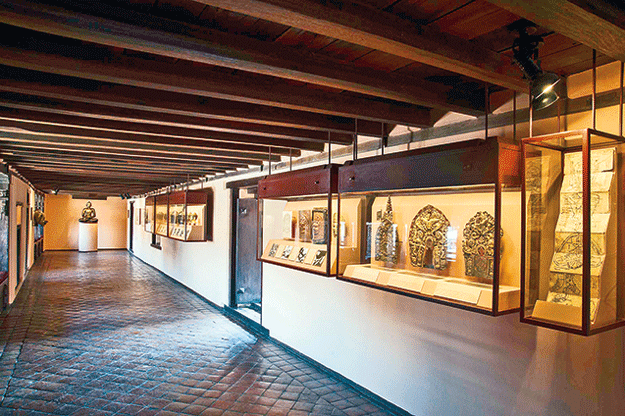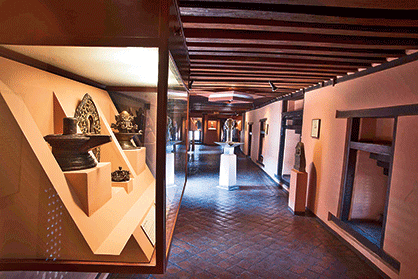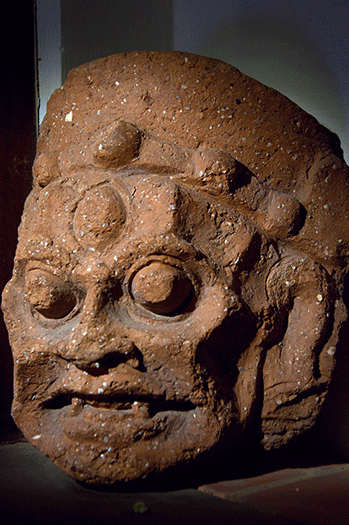
This beautiful, historic palace celebrate twenty years of its new life as a museum, and is worth a visit today as much as ever!
Born out of a UNESCO master plan prepared in 1976, as a museum of religious art, the Patan museum was twenty years in the making, and just recently celebrated its twentieth anniversary in October 2017. The present museum is housed in a renovated palace complex of the Malla kings of Patan, as an adaptive reuse to preserve this ancient historic monument and use it for another purpose than what it was originally built for.
After the annexation of Patan by King Prithvi Narayan Shah in 1768, the capital of Nepal became Kathmandu. The Malla palace of the kingdom of Patan was used as a residence for the relatives of the ruling Shah kings. The massive earthquake of 1934 that damaged and destroyed most houses in the eastern region of Nepal, with a recorded 4,500 deaths in the valley alone, also caused major damages to the palace complex. Without much restoration then, the complex was converted partly into a public school and partly into a revenue office after the advent of democracy in the country. Much later, understanding the cultural and historic value of the complex, the government decided to convert it into a museum.
Previously functional as the National Bronze Art Museum, the Keshav Narayan Chowk got a major facelift and a modern look in 1983 under the aid and support of the Austrian government. Eminent architect and historian of architecture, the late Professor Dr. Eduard Sekler, provided technical support on behalf of the Austrian government.

The first phase of restoration of the durbar complex, where the museum is housed currently, began in 1983 under British architect and conservator John Sanday, who arrived in Nepal in the 1970s under a UNESCO project, and has stayed here ever since. The second phase restoration, till its completion in 1997, was executed by noted Austrian architect and conservator Gotz Hagemullar, whose contribution was more than just restoring the complex, broadening the project plan to make it into a museum complex. In 1991, another architect from Austria, Thomas Schrom, joined the team to speed up the process of completion. Concurrently, the conservation of the bronze images was being taken care under the supervision of Leonhard Stramitz, an expert in metal restoration from Austria.
During the final stages of the completion of the museum restoration and architecture, architect and scholar of Nepalese architecture, Neils Gustchow, imparted his contributions in the making of the state-of-the-art museum we see today. Surprisingly, all the above mentioned architects are still linked with Nepal in their respective professions, and have found various reasons to continue living here till today. Currently, the museum works closely with the Kathmandu Valley Preservation Trust, an international charity committed to safeguarding Nepalese architectural heritage. Its Nepal program is headed by Nepali conservation architect Dr. Rohit Ranjitkar.

While the architecture was in the process of restoration, the section of objects and their research was being made by research associate of the Freer Gallery, Mary Slusser, who is also known famously for her book ‘Nepal Mandala’, which was released in the 1960s. Historian K. P. Malla, in his review of the book, mentions it as ‘the clearest outline of Nepalese history in any language’, besides noting that Slusser’s greatest achievement in the book was to make the cultural materials of Nepal understandable to all, which every reader will strongly agree with. Slusser listed almost 1500 artifacts from the government’s collection, and then shortlisted approximately 200 masterpieces of bronze and stone art related to Buddhism and Hinduism for display. Although selection of the objects is one of the most important tasks of curating an exhibition, the textual interpretations play a vital task in the satisfaction of the visitors. Slusser at that time made comprehensive label texts for each of the objects, instead of just providing basic information about the title, material, and date of the objects, a practice seen in other museums of Nepal. Unfortunately, such an important example set by Slusser has not been followed by the other state museums even till today.
Inaugurated on October 28, 1997, by the late King Birendra BB Shah Dev in the presence of Austrian Minister of Foreign Affairs, Mrs Benita Ferrero-Waldner, Patan Museum can be considered a national treasure and a popular destination for tourists visiting the country. Since the last five years, the statistics of museums visitors show a two-fold increase, with a notable number of local visitors, too. Currently, it holds a semi-autonomous status, unlike other state museums of Nepal, and is managed by its own board of directors, while the Department of Archaeology, the custodian of all national heritages, retains its legal authority of collection and conservation control.

The Patan Museum we visit today was, in historical documents, referred to as the ‘Chaukot Durbar’, denoting a fort or a castle with four towers. Today, only the two towers at the corners of the front façade exist. As we enter through the main doorway, we enter Keshav Narayan Chowk, which got is name from the temple at the center of the courtyard dedicated to Lord Vishnu. This courtyard has souvenirs shops, open columned porticos, and the ticket counter. It opens up to another courtyard, with a cafe tucked into the pleasing and relaxing greenery of the complex. The permanent exhibition, a large collection of Buddhists and Hindu deities, are aesthetically as well as scientifically exhibited here. Exquisite gilt copper repousse and bronze, wood, and stone images and structures adorn the galleries, making them a very popular tourist destination.
Recently opened is the architectural gallery, as well as a gallery that displays the drawings of the various heritage monuments of the valley. Besides these permanent exhibitions, the museum boasts the resplendent art and architecture of the central Mulchowk and Sundari Chowk. Wooden struts, ornate windows and doorways, intricately carved pillars of the porticos, the minutely carved stone and metal deities. These matchless masterpieces are witnesses of the meticulous craftsmanship and finesse of the artist and the impassioned patron’s love and extravagance for such immaculate art.
With continuous efforts of the museum staff and others related to the museum, Patan Museum has been successful in conserving and preserving the heritage and culture of Nepal. It is a place where one can learn about the rich legacy our ancestors left behind, and help us take pride in our history and identity. With the recent increase in local visitor numbers, it has also become a relevant and socially-engaging space for the local communities, a necessary feature for present day museums!
The author is a scholar of Nepalese culture, with special interest in art and iconography. She can be reached at swostirjb@gmail.com










